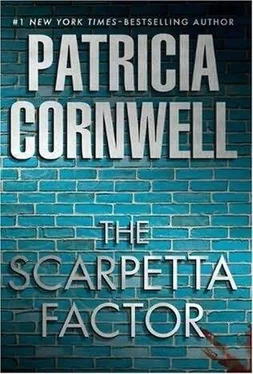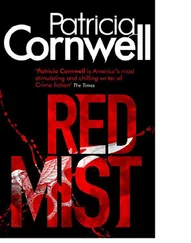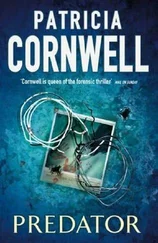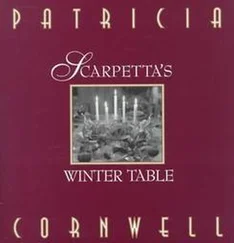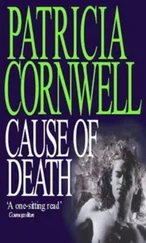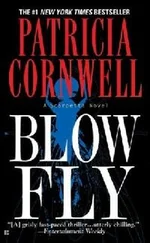The housekeeper seemed perfectly at ease sitting in a library that she had neither tidied nor cleaned in the last three weeks. Were it not for her uniform, she could be the mistress of the mansion, and it was interesting that she called Hannah Starr by her first name and spoke of her in the past tense. Yet Bobby was Mr. Fuller, and he was late. It was four-twenty, and there was no sign of him. Berger wondered if it was possible he wasn’t home, had decided not to meet with them after all. The house was extremely quiet, not even the distant sounds of traffic penetrated the limestone walls, and there were no windows in here, the space like a mausoleum or a vault, perhaps to protect the rare books, art, and antiques from unwanted exposure to sunlight and moisture.
“It’s all the more terrible she talks about Hannah the way she does,” Nastya went on about Carley Crispin. “Night after night. How do you do that when it’s someone you’ve met?”
“Do you have any idea the last time Carley was here?” Berger asked, getting out her phone.
“I don’t know.”
“You said she bothers Mr. Fuller.” Bonnell got back to that. “She knows him, maybe because of Hannah?”
“I just know she’s called here.”
“How does she have the number?” Bonnell asked.
Berger wanted to try Bobby’s cell phone to see where he was, but she couldn’t get a signal in the library.
“I don’t know. I don’t answer the phone anymore. I’m afraid it might be a reporter. You know, people can find out so much these days. You never know who might somehow get your number,” Nastya said as her eyes wandered to an enormous canvas of clipper ships, what looked like a Montague Dawson that filled a mahogany panel of wall between floor-to-ceiling bookcases.
“Why would Hannah take a taxi?” Bonnell asked. “How did she usually get around when she went out to dinner?”
“She drove herself.” Nastya’s eyes were fixed on the painting. “But if she was going to have a few drinks, she didn’t drive. Sometimes clients or friends gave her a ride or she would use a limo. But you know, you live in New York, no matter who you are, you take taxis if that’s what you need to do. And sometimes she would if it was last minute. All their cars, a lot of them very old and not driven on the street. Mr. Starr’s collection? You’ve seen it. Maybe when you were here, Mr. Fuller showed it to you?”
Berger hadn’t seen it, and she didn’t answer.
“In the basement garage,” Nastya added.
When Bobby Fuller had shown Berger and Marino around, they hadn’t been given a tour of the basement. An antique car collection hadn’t seemed important at the time.
“Sometimes one of them gets blocked in,” Nastya said.
“Blocked in?” Berger said.
“The Bentley, because Mr. Fuller had been moving things around down there.” Nastya’s attention returned to the maritime painting. “He’s very proud of his cars and spends a lot of time with them.”
“Hannah couldn’t drive her Bentley to dinner because it was blocked in,” Berger repeated.
“The weather was messy, too. And all those cars, and most you can’t take out. The Duesenberg. Bugati. Ferrai.” She didn’t pronounce them right.
“Maybe I’m confused,” Berger said. “I thought Bobby wasn’t home that night.”
Scarpetta sat at the work station, alone in the training lab, Lucy and Marino having left moments ago to find Berger and Benton.
She continued to review what Geffner was sending and what was rolling by on the other two monitors, studying multilayered paint chips, one chrome-yellow, the other racecar-red, and data that moved Toni Darien’s life minute by minute closer to its end.
“The debris you collected from Toni Darien’s head wound and particularly from her hair,” Geffner said over speakerphone. “I cross-sectioned the ones you’re looking at but haven’t had a chance to Melt Mount any of the samples yet, so this is rough, really quick and dirty. You got the images up?”
“I’ve got them.” Scarpetta looked at the paint chips, and she looked at charts and maps and a multitude of graphs.
Thousands of reports from the BioGraph, and she couldn’t pause the images or replay them or skip forward, had no choice but to look at data as Lucy’s programs sifted through and sorted it. The process wasn’t fast enough or facile, and it was confusing. The problem was Caligula. They didn’t have the proprietary software that had been developed for the express purpose of aggregating and manipulating the galaxy of data collected by the BioGraph devices.
“The chrome-yellow chip is an oil-based paint, an acrylic melamine and alkyd resin, from an older vehicle,” Geffner was explaining. “And then the red chip. That’s much newer. You can tell because the pigments are organic-based dyes versus inorganic heavy metals.”
Scarpetta had been following Toni Darien through Hannah Starr’s house for the past twenty-seven minutes, Toni Darien’s minutes, from three-twenty-six p.m. to three-fifty-three p.m. this past Tuesday. During that interval, the ambient temperature of the Park Avenue mansion had remained between sixty nine and seventy two as Toni had moved through different areas of it, her pace slow and sporadic, her heart rate not peaking above sixty-seven, as if she was relaxed, maybe walking around and talking to someone. Then the temperature suddenly began to drop. Sixty-nine to sixty-five to sixty-three and falling, while her mobility was constant, ten to twenty paces every fifteen seconds, a leisurely pace. She was walking somewhere in the Starr house where it was cooler.
“Obviously, the paint wasn’t transferred from the weapon,” Scarpetta said to Geffner. “Unless it was painted with automotive paint.”
“More likely a passive transfer.” Geffner’s voice. “Either from whatever she was struck with or possibly a vehicle that transported her body.”
Sixty degrees, fifty-nine, fifty-eight, and falling as Toni continued to move, her pace slow. Eight steps. Three steps. Seventeen steps. No steps. One step. Four steps. Every fifteen seconds. Temperature fifty-five degrees. It was cool. Her mobility was consistent. She was walking and stopping, maybe talking, maybe looking at something.
“Not from the same source unless it’s another passive transfer,” Scarpetta said. “A yellow paint chip is from an older vehicle, the red one from a vehicle that’s much newer.”
“Exactly. The pigments in the chrome-yellow chips are inorganic and contain lead,” Geffner said. “I already know I’m going to find lead even though I haven’t used micro-FTIR, pryolysis GC-MS. The chips you’re looking at are easily distinguishable from each other in terms of age. The newer paint has a thick, clear protective top coat, a thin base coat with red organic pigment, and then three colored primer coats. The chrome-yellow chip has no clear topcoat and a thick base coat, then primer. A couple of black chips? They’re new, too. Just the yellow’s old.”
More charts and maps slowly rolling by. Three-fifty-nine p.m. Toni Darien time. Four-oh-one p.m. Four-oh-three p.m. Her pulse oximetry ninety-nine percent, her heart rate sixty-six, her pace eight to sixteen steps, illumination a consistent three hundred lux. The temperature had dropped to fifty-five. She was walking around someplace cool and dimly lit. Her vital signs indicated she wasn’t in any sort of distress.
“They haven’t used lead in paint for what?” Scarpetta said. “Twenty-something years?”
“Heavy-metal pigments are the seventies and eighties and earlier because they’re not environmentally friendly,” he answered. “Consistent with fibers you collected from her wound, her hair, various areas of her body. Synthetic monoacrylic, overdyed black, at least fifteen different types I’ve seen so far, which I associate with waste fibers, low-end stuff typical of rugs and trunk liners in older vehicles.”
Читать дальше
